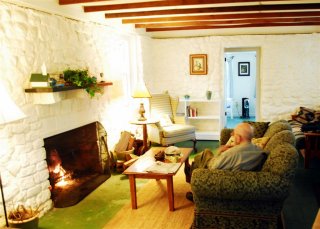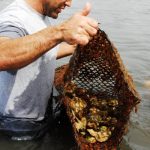The late Rhode Island artist Maxwell Mays had long talked about giving the 300 acres he owned in that state’s rural Coventry to the Audubon Society of Rhode Island upon his passing. Someone asked him why.

Maxwell Mays Wildlife Refuge – cottage from across pond
“I would like this land to stay open,” he said. “I would like this land to breathe.”
He died in 2009, and gave the land that is now known as the Maxwell Mays Wildlife Refuge. This day, atop the hardly towering 609-foot “peak” of Hammitt Hill in the middle of the conservation property named after him, that’s me doing the breathing. And a bit heavily at that, leading me to realize I’m not in the shape I thought I was.
No matter, it’s all about pacing and there are two very well marked trails here, which I do both in a couple relaxing hours, breathing deeply from the occasionally mild exertion of going up a slight hill, taking in the sights and sounds of this forest of pine and oak, wetlands, stone walls, brooks, a small family cemetery, a giant open meadow and a huge pond.
Anyone can hike the property for free – but the really fun part is that you can rent the Maxwell Mays Cottage within it, an old stone structure with two bedrooms, wide open living room with large fieldstone fireplace, fully equipped kitchen and a whopping two-level deck. It is comfortably appointed and well lit, with running water, full toilet and shower, and screened-in porch, all fronting Carr Pond, an 11-acre body of water with dock, perfect for swimming, kayaking, canoeing, fishing or just plain ruminating upon.
After my walk, rumination sounded good. I pulled up a lounge chair, cracked a beer and reveled in doing nothing. There was precious little else to do with no TV, no Internet and spotty cell phone reception.

Maxwell Mays Wildlife Refuge cottage
“This is definitely a one-of-a-kind thing for us,” said Lawrence Taft, executive director of the Audubon Society of Rhode Island. “It’s the only one of our properties we do this with. Normally on Audubon property, buildings are used by caretakers, but this is different. We wanted to attract people from in state and out of state, and saw the potential in doing this, making it available to all people.”
The cottage was renovated and painted in 2010, new appliances installed and electrical and plumbing systems upgraded, before going up for rent mid-summer the next year. One night fetches $160, a full week, $1,000, as of 2012, not bad for the wonder of doing nothing but embracing all that marvelous quiet.
The house is the centerpiece of property, sitting on the pond which is home to river otters and various freshwater fish; osprey can be occasionally seen diving into the water and popping up with a meal. Tossing a fishing line off the dock is a great place to spend time, mattering little that the day I did, I netted nary a nibble.
The entire refuge is comprised of a relatively mature and undisturbed closed-canopy forest and forested wetlands, which Taft said creates ideal conditions for migratory forest interior birds. A 10-acre field near the head of the main trail here also provides excellent meadow wildlife habitat, he said.

Fishing off of a dock at Maxwell Mays Wildlife Refuge
Even fishers have been spotted here, Taft said, a member of the weasel family which 10 years ago were rarely seen. Beaver also inhabit the waterways here, he said.
Mays, who died at 91, was a celebrated artist, most known for his historical paintings of his Rhode Island, and who used to live in another building on the property, as well as in Providence, using the cottage as a guest house. His art appeared on the cover of Yankee magazine dozens of times and he did art for Collier’s magazine as well.
Mays bought the property in 1941; it had been in the Carr family since the early 18th century and its exact history is unknown, Taft said. Mays served in World War II, and his father looked after the land, writing to his son that he’d found a cottage on the property that neither of them knew was there.
“I met Max in 2000, he was talking to people about preserving his land and invited us to talk about it,” Taft said. “Mostly, I listened. He was a very pleasant man who really cared about the land.”

Porch off of cottage at Maxwell May
The cottage also served as a gathering spot for members of the Greene Methodist Church, where Mays was a lay pastor. A panoramic photo inside the cottage shows Mays chatting with a group of people on the deck. None of the artist’s paintings grace the cottage, however.
“I know he gave a lot away to his friends,” Taft said, adding with a laugh, “I wish we had some.”
The sloped hill leading to the dock and pond is thick with pine needles, the sweeping deck shaded by pines, a few small, stately white birches on shore bending toward the water. Sit on the deck and you hear the wind before feeling it, a gentle, building roar swaying trees across the pond before sweeping over the water and you. Sometimes you hear the dull thrum of a truck on Route 95 a few miles away, or a jet flying above. But mostly there’s the sound of birds or breeze or brook – or nothing at all.
The cottage is spare; the living area with wood-beam ceiling and white stone walls, has a pair of couches and a small dining room table, along with cushioned armchair near the large fireplace, the cottage’s sole source of heat. Portable electric radiators are available to cut the night-time chill.
There are two hiking trails here, established with volunteers from the Appalachian Mountain Club, totaling about four miles in all, both easy ambles cutting through forest, over brooks, past stonewalls, and around small, flowery meadows in the woods. Both can be done in a couple of hours at a relaxed pace. Off one trail is the Carr family cemetery plot, a grassy stonewalled enclosure, an official state historical cemetery.

Cemetery at Maxwell Mays Wildlife Refuge
The trails are clear and well maintained and not terribly difficult, though in some spots winding up hills that force deeper breathing; mercifully, flat boulders can be found atop most climbs where a quick rest can be had. One part of a trail cuts through a hilly mound of mossy boulders that is rather Tolkienish in appearance – if you let your mind wander.
The cottage is a good bet for families who prefer a more sedate vacation, disconnected from technology, Taft said, or anyone looking to get away from it all and perhaps toward a touch of inspiration.
“One guest tried finishing a novel here he was writing,” he said. “Another guest was a poet and wrote poetry here.”
Mays was, Taft said, “an individual who was truly connected to this land and wanted to be able to share his passion for nature with the public.”
(For rental information, visit www.lakehousevacations.com/page-6662.html or call 401-949-5454)

Hiking trail at Maxwell Mays Wildlife Refuge


Canoeing awaits at Maxwell Mays Wildlife Refuges – the Carr Pond





May I please have permission to use the Benjamin Carr Lot cemetery photo in a genealogy I’m currently writing?